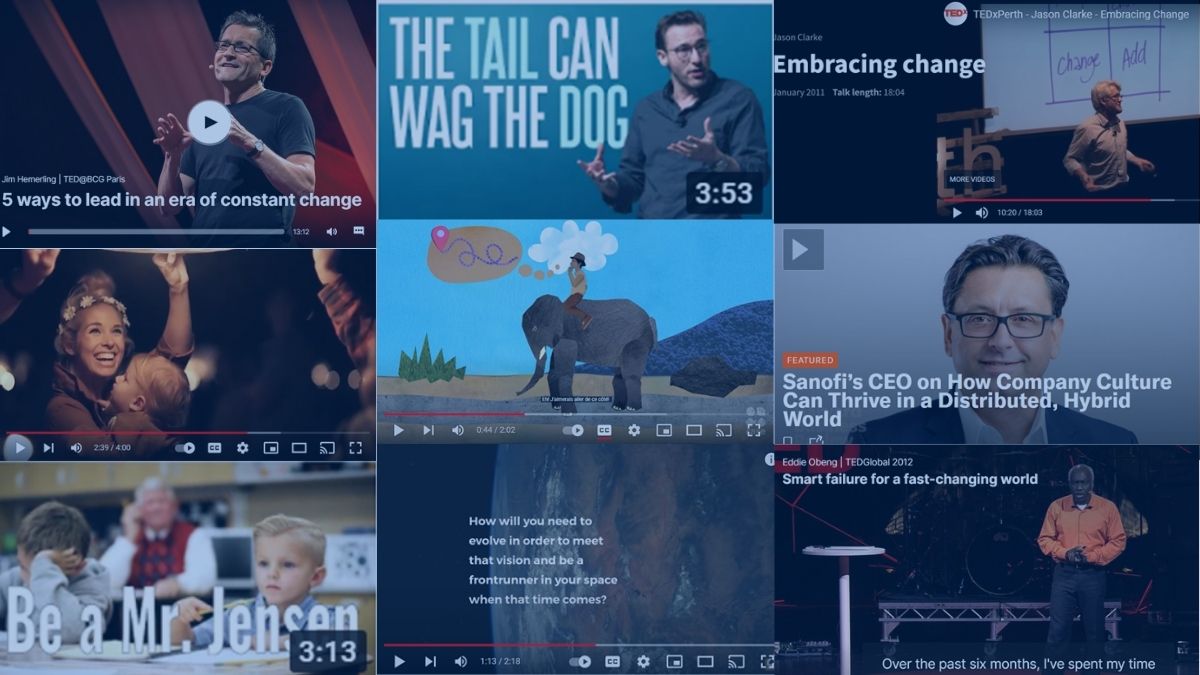New Books on Leadership and Change
Earlier this year, we shared a list of 31 books on leadership and change. Comprised of books we have found helpful in our careers and ones we often recommend to leaders, the list included recent publications and ones that have stood the test of time.
The following list includes books published in 2021 (and one in 2020). Each of these books is timely, insightful, and one to consider adding to your reading list – and library.
8 Insightful New Reads
Rethinking Competitive Advantage: New Rules for the Digital Age by Ram Charan (2021)
Drawing on the inner workings of the likes of Netflix, Amazon and Alibaba, Ram Charan explains what makes the digital giants soar. He defines the six unwritten rules they seem to follow for using their digital platforms, ecosystems, moneymaking models, team-based structures, and leadership with a laser-sharp focus on the individual’s customer experience.
But these rules are not the preserve of Silicon Valley. Charan shows that they now apply to any company that wants to win against the competition. And with stories of how traditional companies like Fidelity Investments, Walmart, and B2W have adopted them, he offers a practical toolbox for applying them to your business, starting today.
Digital Body Language: How to Build Trust and Connection, No Matter the Distance by Erica Dhawan (2021)
Humans rely on body language to connect and build trust, but with most of our communication happening from behind a screen, traditional body language signals are no longer visible — or are they? In Digital Body Language, Erica Dhawan, a go-to thought leader on collaboration and a passionate communication junkie, combines cutting-edge research with engaging storytelling to decode the new signals and cues that have replaced traditional body language across genders, generations, and culture. In real life, we lean in, uncross our arms, smile, nod and make eye contact to show we listen and care. Online, reading carefully is the new listening. Writing clearly is the new empathy. And a phone or video call is worth a thousand emails.
Digital Body Language will turn your daily misunderstandings into a set of collectively understood laws that foster connection, no matter the distance. Dhawan investigates a wide array of exchanges―from large conferences and video meetings to daily emails, texts, IMs, and conference calls―and offers insights and solutions to build trust and clarity to anyone in our ever-changing world.
Unleashed: The Unapologetic Leader’s Guide to Empowering Everyone Around You by Frances Frei and Anne Morriss (2020)
In Unleashed, Frances Frei and Anne Morriss argue that the most important thing you do as a leader is build others up. Leadership isn’t about you. It’s about how effective you are at empowering other people—and making sure that this impact endures even in your absence. As Frances and Anne show through inspiring stories from ancient Rome to Silicon Valley, the origins of great leadership are found, paradoxically, not in worrying about your own status and advancement, but in the unrelenting focus on other people’s potential.
Unleashed provides radical advice for the practice of leadership today. Showing how the boldest, most effective leaders use a special combination of trust, love, and belonging to create spaces where other people can excel, Frances and Anne offer practical, battle-tested tools—based on their work in companies such as Uber, Riot Games, and others—along with interviews and stories from their own personal experience to make these ideas come alive. This book is your indispensable guide for unleashing greatness in other people . . . and, ultimately, in yourself.
Think Again by Adam Grant (2021)
Intelligence is usually seen as the ability to think and learn, but in a rapidly changing world, there’s another set of cognitive skills that might matter more: the ability to rethink and unlearn. In our daily lives, too many of us favor the comfort of conviction over the discomfort of doubt. We listen to opinions that make us feel good, instead of ideas that make us think hard. We see disagreement as a threat to our egos, rather than an opportunity to learn. We surround ourselves with people who agree with our conclusions, when we should be gravitating toward those who challenge our thought process. The result is that our beliefs get brittle long before our bones. We think too much like preachers defending our sacred beliefs, prosecutors proving the other side wrong, and politicians campaigning for approval–and too little like scientists searching for truth. Intelligence is no cure, and it can even be a curse: being good at thinking can make us worse at rethinking. The brighter we are, the blinder to our own limitations we can become.
Think Again reveals that we don’t have to believe everything we think or internalize everything we feel. It’s an invitation to let go of views that are no longer serving us well and prize mental flexibility over foolish consistency. If knowledge is power, knowing what we don’t know is wisdom.
How to Change by Katy Milkman (2021)
Change comes most readily when you understand what’s standing between you and success and tailor your solution to that roadblock. If you want to work out more but find exercise difficult and boring, downloading a goal-setting app probably won’t help. But what if, instead, you transformed your workouts so they became a source of pleasure instead of a chore? Turning an uphill battle into a downhill one is the key to success.
Drawing on Katy Milkman’s original research and the work of her world-renowned scientific collaborators, How to Change shares strategic methods for identifying and overcoming common barriers to change, such as impulsivity, procrastination, and forgetfulness. Through case studies and engaging stories, you’ll learn:
– Why timing can be everything when it comes to making a change
– How to turn temptation and inertia into assets
– That giving advice, even if it’s about something you’re struggling with, can help you achieve more
The Burnout Epidemic: The Rise of Chronic Stress and How We Can Fix It by Jennifer Moss (2021)
We tend to think of burnout as a problem we can solve with self-care: more yoga, better breathing techniques, and more resilience. But evidence is mounting that applying personal, Band-Aid solutions to an epic and rapidly evolving workplace phenomenon isn’t enough—in fact, it’s not even close. If we’re going to solve this problem, organizations must take the lead in developing an antiburnout strategy that moves beyond apps, wellness programs, and perks.
In this eye-opening, paradigm-shifting, and practical guide, Jennifer Moss lays bare the real causes of burnout and how organizations can stop the chronic stress cycle that an alarming number of workers suffer through. The Burnout Epidemic explains:
- What causes burnout—and what organizations can do to prevent it
- Why traditional wellness initiatives fall short
- How companies can build an antiburnout strategy based on prevention, not perks
- How leaders can measure burnout in their own organizations
- What leaders can do to develop a healthier culture that prioritizes resilience and curiosity
How the Word Is Passed: A Reckoning with the History of Slavery Across America by Clint Smith (2021)
Beginning in his hometown of New Orleans, Clint Smith leads the reader on an unforgettable tour of monuments and landmarks—those that are honest about the past and those that are not—that offer an intergenerational story of how slavery has been central in shaping our nation’s collective history, and ourselves.
A deeply researched and transporting exploration of the legacy of slavery and its imprint on centuries of American history, How the Word Is Passed illustrates how some of our country’s most essential stories are hidden in plain view—whether in places we might drive by on our way to work, holidays such as Juneteenth, or entire neighborhoods like downtown Manhattan, where the brutal history of the trade in enslaved men, women, and children has been deeply imprinted.
Impact Players Liz Wiseman (2021)
In every organization there are Impact Players—those indispensable colleagues who can be counted on in critical situations and who consistently receive high-profile assignments and new opportunities. Whether they are on center stage or behind the scenes, managers know who these top players are, understand their worth, and want more of them on their team. While their impact is obvious, it’s not always clear what actually makes these professionals different from their peers.
In Impact Players, New York Times bestselling author and researcher Liz Wiseman reveals the secrets of these stellar professionals who play the game at a higher level. Drawing on insights from leaders at top companies, Wiseman explains what the most influential players are doing differently, how small and seemingly insignificant differences in how we think and act can make an enormous impact, and why—with a little coaching—this mindset is available to everyone who wants to contribute at their highest level.







